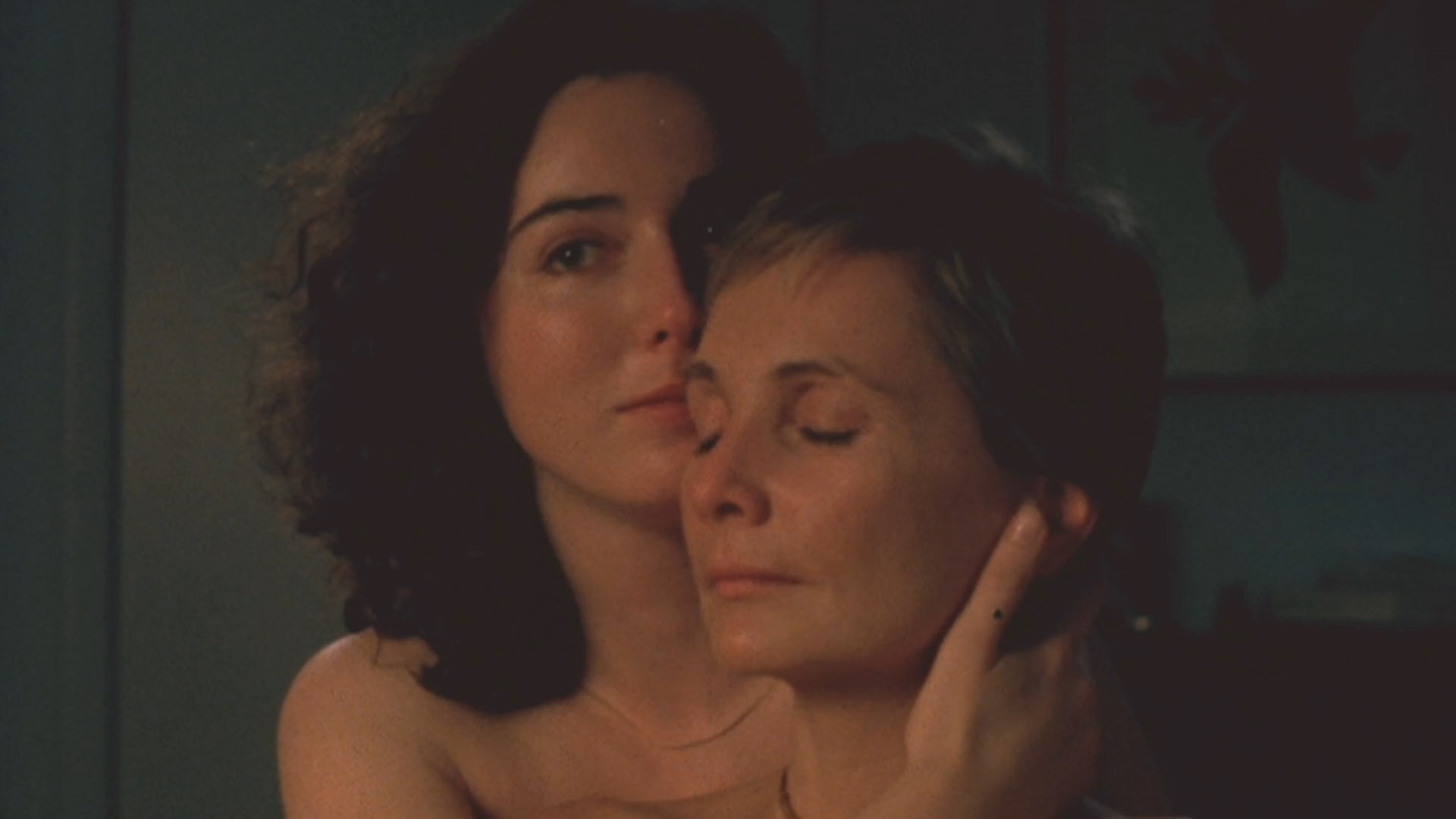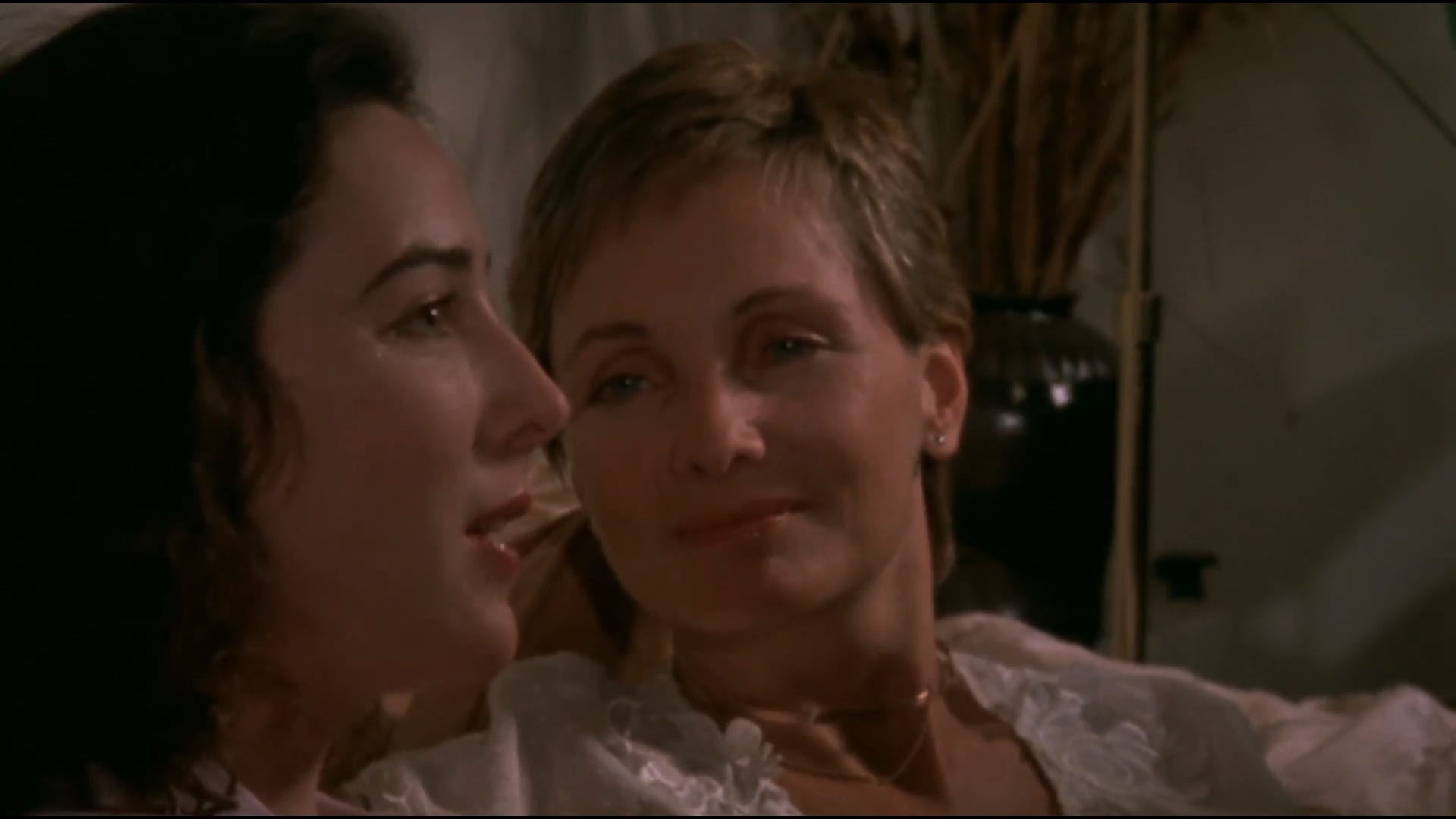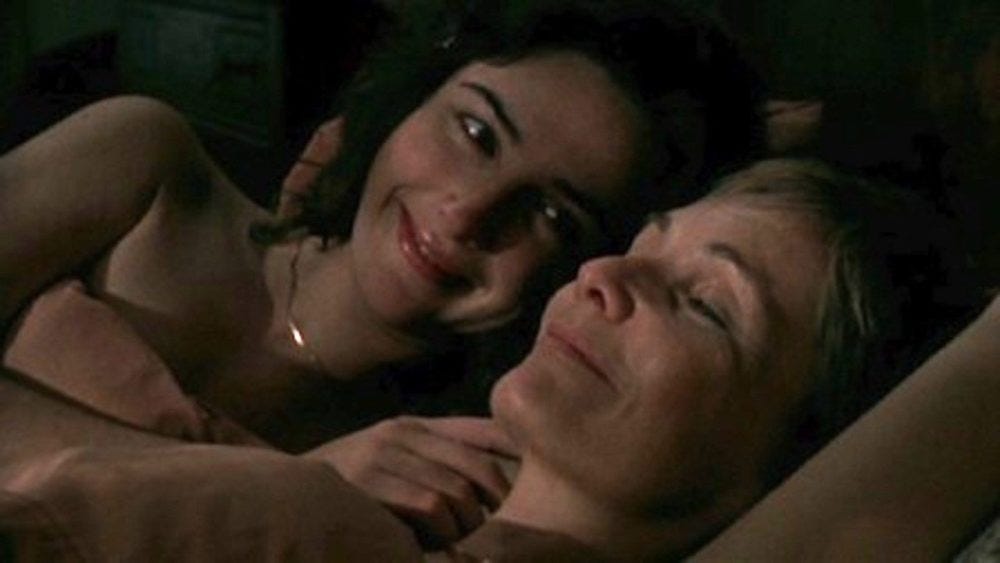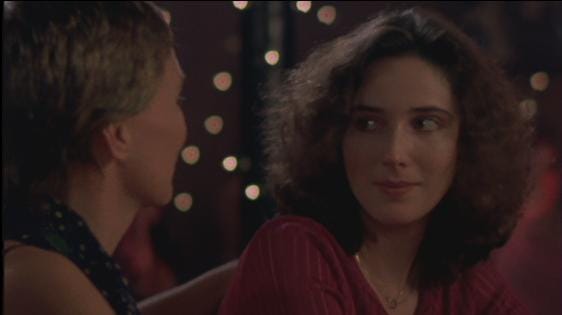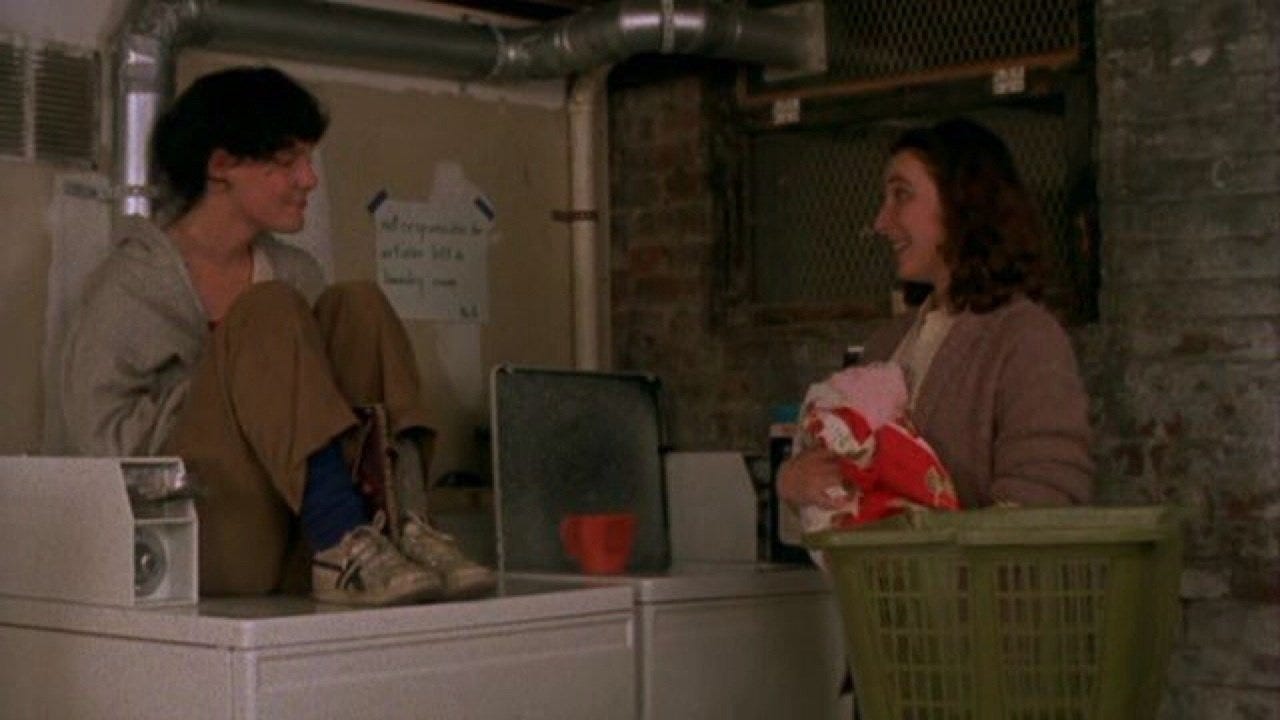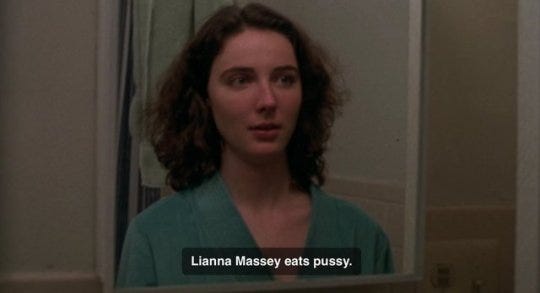Paging Dr. Lesbian - Discovering "Lianna"
This is the Sunday Edition of Paging Dr. Lesbian. If you like this type of thing, subscribe, and share it with your friends. Upgrade your subscription for more, including this week’s dispatch from the lesbian internet, where we talked about The Oscars and I released my exclusive monthly playlist. The following contains a discussion of the plot of Lianna – if you want to watch it beforehand, it’s available to stream on AMC+ and rent on Apple TV+ in the U.S. Considering the broader history of American queer cinema in the 20th century, the fact that four different movies with ostensibly queer themes were released in 1982 is something of a breakthrough. The films in question are Personal Best, which depicts a lesbian relationship within the athletic world, Making Love, about a married doctor who begins an affair with another man, and Tootsie and Victor/Victoria, in which both the lead characters cross-dress. While the 1985 film Desert Hearts is often referred to as the first mainstream lesbian film to depict lesbians in a positive light, 1983 saw the release of an independent lesbian film that is often left out of this history. Lianna follows the titular character, a woman in her thirties who is married to a college professor. Lianna (Linda Griffiths) dropped out of college to get married and have kids, and now she’s a bored housewife looking for intellectual stimulation. Lianna and her best friend Sandy (Jo Henderson) decide to take a night class on child psychology. Their professor is a middle-aged woman named Ruth (Jane Hallaren), with whom Lianna quickly becomes infatuated. The two embark on a passionate affair, and Lianna endeavors to embrace her newfound lesbian identity despite the negative responses from those around her. The film was written and directed by John Sayles, an independent filmmaker known for projects such as Passion Fish and Lone Star, and the movie is as independent as a film can be. Due to the nature of its subject matter, conventional investors balked at the idea of producing the film. Thus, the entire picture was funded by individual first-time film investors, and the budget came out to $340,000. (It would go on to make $1.5 million at the box office.) The result of this economical production is a stripped-back, grounded film not about lesbians as a group, but about an individual lesbian and her encounters with the world around her. The filmmaking style is understated, with prolonged silences that emphasize the awkward reality of human behavior. From the start, what’s made obvious about Lianna is that she has been a passive figure in her story. When she describes the trajectory of her life – from student to wife – it sounds as if it was something that simply happened to her, rather than anything she was an active participant in. When she meets Ruth, things begin to shift for Lianna. She experiences true adult attraction for the first time and simultaneously realizes she’s always had this lesbian desire within her. When they share their first kiss, it feels almost inevitable. Lianna sits on Ruth’s couch, describing a sexually charged relationship she once had with another girl at summer camp. Lianna faces forward, with the camera placed on the side of her face, while Ruth stares at Lianna’s profile and gently strokes her hair, her gaze facing the viewer. When Lianna finally finishes her story, Ruth silently leans forward and kisses Lianna with a notable lack of trepidation. Their first lovemaking scene – and this is certainly the right word for it – is a distinct departure in terms of style from the rest of the film. Gone are the straightforward framing and natural colors. Instead, Ruth’s bedroom is shot with a blue filter, and the camera hones in on the embrace of limbs rather than depicting the full picture. Their affections are scored not by music, but by poetic whisperings in French. This dialogue is taken directly from Alain Resnais’ 1959 masterpiece, Hiroshima mon amour, which was written by French feminist Marguerite Duras. It’s an ambitious digression, and it recalls the highly stylized love scene from Carol more than it does the easygoing verisimilitude of the rest of the film. Nonetheless, it manages to avoid the voyeurism that characterized much lesbian media from the era (and thereafter), a criticism that was in fact lobbed at Personal Best, the lesbian film that was released the year prior. Lianna is excited by this new development – both first love and sexual satisfaction – and wants to share it with the world, but Ruth, who presumably came out in a different era, is hesitant. In a fit of passion one evening, Lianna tells her husband (Jon DeVries) about the affair, and he reacts with anger and disgust and kicks her out of the house. (The fact that he has been having affairs with his students all this time is apparently of no consequence to him.) Lianna thinks she will go live with Ruth, but Ruth says that’s not possible, so Lianna is forced to live on her own for the first time. Lianna’s relationship with Ruth mirrors the relationship with her husband a little too closely, and Ruth decides that Lianna should no longer work as her research assistant now that they’re engaged in a relationship. But Ruth doesn’t abandon Lianna entirely, and instead introduces her to the great big lesbian world in the form of a lesbian bar. Lianna is nervous at first and worries that everyone is looking at her - a few of them are – but she eventually relaxes enough to let loose on the dance floor. The dancing here is wonderfully silly, and Ruth looks on with pride as Lianna becomes more emboldened by this unfamiliar freedom. The film depicts Lianna coming of age and Ruth as her older, wiser guide, a dynamic that is quite common in queer films across decades. Ruth is a child psychologist without a child, and Lianna – a mother of two – is both a research source and a child (so to speak) in need of rearing. This scene – and the other bar scene that comes later in the film – is significant not just as it pertains to the narrative, but also because it preserves on-screen a kind of space that is often understood as endangered. Indeed, the number of lesbian bars in America has actually declined since the film was made, and the bar depicted in the film almost certainly does not exist any longer. (Because of this archival aspect, the film was included in Metrograph's Muff Dives: The Dyke Bar In Cinema series.) Sayles has (rightly) noted that Lianna is not meant to represent all gay women, but her entry into this lesbian space that no longer exists in the way it once did feels like a significant act of preservation. Lianna learns that Ruth has a long-term partner in another city, her husband has kicked her out of her home, and her best friend has been avoiding her. She’s forced to go out into the world on her own, something that’s difficult due to the fact that she has no money (or credit) to speak of. While Ruth leaves to go home and decide whether she will stay with her partner or not, Lianna returns to the lesbian bar that Ruth took her to. This time she is no longer afraid of the glances of other women, and responds enthusiastically when someone hits on her. The two women return to Lianna’s apartment to have sex. The scene is markedly different from the first love scene with Ruth. There is no blue filter, no mumbled French, and the scene employs the naturalistic, no-frills style of the rest of the film. Though it still excites her, lesbian sex is no longer a novelty for Lianna, nor is it for the viewer. In addition to following Lianna’s own journey to empowerment, much of the film tracks the reactions of others to this new development in her life. Her husband, aptly named Dick, is a total hypocritical jerk about it. Her friend Sandy is rather grossed out by it, and announces, “I don’t even like to think of the two of them together.” In response, their charismatic friend Jerry, who is played by Sayles, says, “Well, I’m from California, that kind of stuff doesn’t phase me.” It’s a needed moment of levity, and it also represents the liberal viewpoint of mild-mannered straight people who might enjoy the film, in addition to Sayle’s own self-congratulatory attitude of acceptance. Against Lianna’s wishes, Dick tells their children that Lianna has left the family because she’s into women now. Her daughter is hurt that Lianna has left and gives her mother the cold shoulder. Her teenage son takes the news fairly well, telling Lianna "So my old lady's a dyke--big deal." The first time Lianna comes out to a stranger is in the laundry room of her new apartment. She tells her neighbor, without preamble, that she’s gay, and then dissolves into an uncontrollable fit of laughter. It’s a delightful scene – Griffiths is magnetic here – and the casual nature of her coming-out is rather soothing to a viewer who might have expected more conflict and hardship. By the end of the film, Lianna has learned how to stand on her own feet –without her husband and without Ruth – and begins repairing her relationship with Sandy, a process that points to a decidedly hopeful future. Though Lianna tackles a topic that was still understood as quite controversial at the time, the film almost entirely avoids melodrama. The entire movie is quite understated and the acting naturalistic, which gives it an almost documentary-like feel. Griffiths is incredible in the lead role. She is at once charming and petulant, energetic and morose, and bursting with vitality and passion. Though the film is sensitively written and directed by Sayles, she carries the story on her back. Upon its initial release, Lianna was reviewed positively by mainstream publications. The New York Times gave it a positive review, highlighting the earthy style and the hidden effort that went into creating it. The film wasn’t wholly embraced by lesbian critics, some of whom found the film overly placating. Writing in Jump Cut, Lisa DiCaprio concluded that the film lacked a political bent and was primarily made with straight viewers in mind. “The ultimate result of this perspective promotes an ideology of tolerance, rather than liberation,” she suggested. DiCaprio maintained that Sayle’s insistence on normalizing lesbian existence and implying that they’re just like straight folks actually serves to diminish the unique needs of lesbians and their denigration within the social and political spheres. Angela Marney, writing in the radical feminist newspaper off our backs, went so far as to call the lesbian bar scene “lecherous,” arguing that it conflates the behavior of lesbians with that of straight men. These critiques are not entirely unfounded, but the film also reads quite differently today. It’s true that it’s not an especially political film, but that inward-looking (rather than outward-looking) bent is baked into the narrative itself. It is an intimate story of one woman coming to terms with herself in an environment that is not entirely hospitable to her – though not totally inhospitable either. It is certainly not representative of the experiences of all lesbians – something no single film could accomplish – but it is notable for being concerned with a lesbian experience on a personal, primarily emotional level. In many ways, the film appears as something like a time capsule, remarkable primarily for its attempts to capture the life of a woman in her unique context. It makes sense that queer viewers might have been highly critical of the film at the time, given that lesbians were almost entirely absent from film and television during this period. As such, a film like this could certainly have had an effect on viewers’ overall opinions of lesbians, even as singular as the story purports to be. Of course, “what does the film say about lesbians” is a different question than “what does it say about our title character,” and the passage of time has allowed us to focus more on the latter question than the former. Taking a step – and several decades – back, an intimate snapshot of life emerges. The political meaning of lesbian existence is mostly overlooked, which means we are forced to focus on Lianna’s insular inner world. Her social constraints are limited, rather than expansive, and so is the film. Perhaps surprisingly, the ultimate message here is that love is not the answer, but self-empowerment probably is. Lianna is not necessarily a revelation, but it is a heartening answer to homophobia and fetishization. Its success lies in the small moments and the emotional discoveries, rather than some big explosion. You’re a free subscriber to Paging Dr. Lesbian. For the full experience, which includes weekly dispatches from the lesbian internet, become a paying subscriber. Your support means a lot! |
Older messages
Ready Or Not, Here Comes Mama
Sunday, March 12, 2023
To Wong Foo is an unlikely '90s classic, but how does it resonate today?
The Queer Danger of Girl, Interrupted
Sunday, March 5, 2023
Or, The Conclusion of Angelina Jolie's Queer '90s Trilogy
Does The Female Gaze Exist?
Sunday, February 26, 2023
Feminist theory takes on Tik Tok
a brief interruption
Sunday, February 19, 2023
*cough cough*
The Lesbian Tragedy of 'Gia'
Sunday, February 12, 2023
Tragedy is one of the oldest recognized classical art forms. More specifically, it's considered a classical art form, and is closely associated with the playwrights of Ancient Greece. Within
You Might Also Like
6 Most Common Tax Myths, Debunked
Saturday, March 8, 2025
How to Finally Stick With a Fitness Habit. Avoid costly mistakes in the days and weeks leading up to April 15. Not displaying correctly? View this newsletter online. TODAY'S FEATURED STORY Six of
Weekend: My Partner Can’t Stand My Good Friend 😳
Saturday, March 8, 2025
— Check out what we Skimm'd for you today March 8, 2025 Subscribe Read in browser Header Image But first: this is your sign to throw away your old bras Update location or View forecast EDITOR'S
Your Body NEEDS to Cardio Row! Here Are Some Options.
Saturday, March 8, 2025
If you have trouble reading this message, view it in a browser. Men's Health The Check Out Welcome to The Check Out, our newsletter that gives you a deeper look at some of our editors' favorite
What Do You Really Need?
Saturday, March 8, 2025
Is opposing consumerism lacking gratitude? ͏ ͏ ͏ ͏ ͏ ͏ ͏ ͏ ͏ ͏ ͏ ͏ ͏ ͏ ͏ ͏ ͏ ͏ ͏ ͏ ͏ ͏ ͏ ͏ ͏ ͏ ͏ ͏ ͏ ͏ ͏ ͏ ͏ ͏ ͏ ͏ ͏ ͏ ͏ ͏ ͏ ͏ ͏ ͏ ͏ ͏ ͏ ͏ ͏ ͏ ͏ ͏ ͏ ͏ ͏ ͏ ͏ ͏ ͏ ͏ ͏ ͏ ͏ ͏ ͏ ͏ ͏ ͏ ͏ ͏ ͏ ͏ ͏ ͏ ͏ ͏ ͏ ͏ ͏
“Otway” by Phoebe Cary
Saturday, March 8, 2025
Poet, whose lays our memory still / Back from the past is bringing, ͏ ͏ ͏ ͏ ͏ ͏ ͏ ͏ ͏ ͏ ͏ ͏ ͏ ͏ ͏ ͏ ͏ ͏ ͏ ͏ ͏ ͏ ͏ ͏ ͏ ͏ ͏ ͏ ͏ ͏ ͏ ͏ ͏ ͏
Cameron Diaz Returned To Fashion Week In A Fabulous Little Red Dress
Saturday, March 8, 2025
WOW. The Zoe Report Daily The Zoe Report 3.7.2025 Cameron Diaz's Asymmetrical Red Dress Lit Up The Stella McCartney Fall 2025 Show (Celebrity) Cameron Diaz Returned To Fashion Week In A Fabulous
5-Bullet Friday — Breaking the Sperm Bank, D-Cycloserine, Tools for Grumpy Elbows, and Wisdom from Seth Godin
Saturday, March 8, 2025
“If you're feeling creative, do the errands tomorrow. If you're fit and healthy, take a day to go surfing. When inspiration strikes, write it down." ͏ ͏ ͏ ͏ ͏ ͏ ͏ ͏ ͏ ͏ ͏ ͏ ͏ ͏ ͏ ͏ ͏ ͏ ͏ ͏
Inside Alex Pereira's Training for Saturday's UFC 313 Showdown
Friday, March 7, 2025
View in Browser Men's Health SHOP MVP EXCLUSIVES SUBSCRIBE Inside Alex Pereira's Training for Saturday's UFC 313 Showdown Inside Alex Pereira's Training for Saturday's UFC 313
Update Your Android Devices Now 🚨
Friday, March 7, 2025
This TikTok Cleaning Method Might Have Broken My Fan. The security update includes fixes for two zero-day exploits. Not displaying correctly? View this newsletter online. TODAY'S FEATURED STORY
EmRata's Itty-Bitty Bikini Just Brought Back This "Cheugy" 2010s Trend
Friday, March 7, 2025
Plus, everything you need to know about Venus retrograde, your daily horoscope, and more. Mar. 7, 2025 Bustle Daily New books from Emily Henry, Karen Russell, and Kate Folk are among Bustle's best

